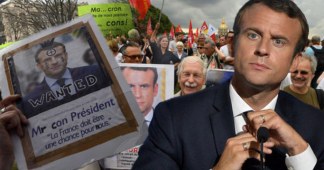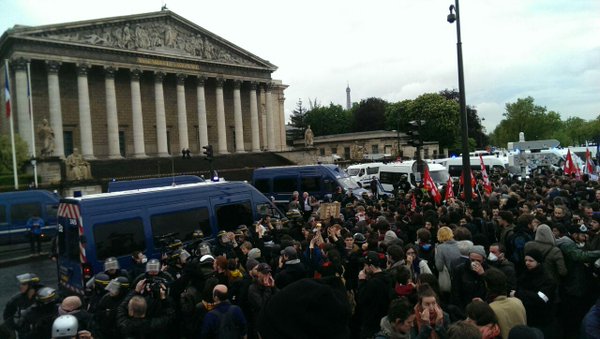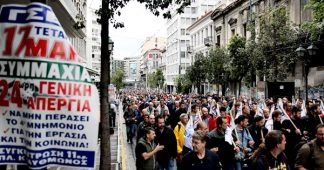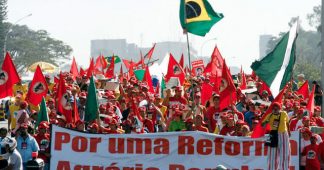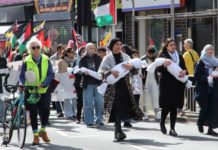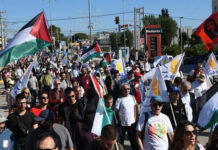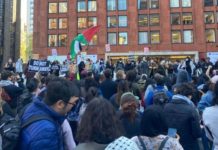Published originally as “Bilan de l’extrême-gauche au Québec” in Quatrième Internationale, No. 21, September 1986. Available on the web site of Gauche socialiste, and at the Socialist History Project.
by François Moreau
Translation by Richard Fidler
The far-left organizations developed rapidly in Quebec during the Seventies but suffered a dramatic collapse in the early Eighties, particularly in the case of the Mao-Stalinist organizations that had dominated the left for almost a decade. This article is offered as a contribution to our understanding of these developments and the lessons we can learn from them.
Like all the advanced capitalist countries, Quebec experienced a rise in militant struggles in the late Sixties and early Seventies. The movement for Quebec’s national liberation began to develop a new élan in the mid-Sixties around renewed support for the independence of Quebec, largely on the basis of the youth and student radicalization during that period. Beginning in 1971, the workers movement in turn experienced a significant radicalization with a growing number of hard-fought strikes and increasing politicization of labour conflicts. The adoption by the three major central trade-union bodies of manifestoes with a socialist theme reflected the rise in class confrontations in Quebec in the early Seventies.
Political Context
In political terms, however, this rise of the workers movement took the form on a mass scale of increased electoral support for the Parti québécois, a bourgeois nationalist party. This phenomenon is explained by the absence of any mass workers party in Quebec notwithstanding the organizational strength of the working class in its trade unions. Social democracy, which was hegemonic in the English-Canadian workers movement through the New Democratic Party, never managed to gain a serious foothold in the Quebec working class owing to the NDP’s hostility to Quebec’s national rights. For the same reason the pro-Moscow Communist party could never be more than a small group. The major political currents in the Western workers movement were virtually non-existent in the Quebec working class.
The need for independent political action had been perceived many times throughout the history of workers’ struggles in Quebec. But the union leaderships had consistently opposed the formation of a workers party and always managed to channel the workers’ desire for change toward whatever appeared to be the most “progressive” bourgeois party. However, during the 1950s the Fédération des unions industrielles du Québec [FUIQ – Quebec Industrial Unions Federation] came close to endorsing a proposal to found a workers party to fight the retrograde and corrupt Union nationale regime.
In 1966, after steering the province through six years of “quiet revolution”, the Quebec Liberal party lost the general election. Soon afterwards, it experienced a split by its more nationalist and self-proclaimed progressive wing, which went on to found the Mouvement souveraineté-association around the personality of René Lévesque, a former government minister whose popularity was based largely on his role in the nationalization of Quebec’s electricity industry in 1963. The MSA proposed to rebuild a new bourgeois nationalist party that could take the leadership of and co-opt the national liberation movement that was then developing in Quebec. The MSA did in fact manage to absorb the existing radical nationalist formations with the foundation of the Parti québécois in 1968. The PQ’s relative breakthrough in the 1970 elections, when it won 23% of the popular vote, again confronted the labour movement with a choice between founding its own party or supporting this new party that still seemed quite radical at least as far as its written program was concerned.
After some wavering, the leaderships of the central union bodies ultimately opted to reject a workers’ party and to support the Parti québécois. This orientation relied on the nationalist-populist radicalization of the Quebec working class, which was especially strong among workers employed by multinational corporations who saw the class enemy as a manifestation of their national oppression. Thus, the radicalization of the workers movement was expressed both by a major increase in tough strikes economically and by a rise in bourgeois nationalism politically. There was a complete disjunction, therefore, between the powerful radicalization of the Quebec working class and its weak politicization.
The labour movement’s support to the Parti québécois was not foreordained, however. Militants in the labour movement were striving in a more or less confused way to engage in independent political action, and the proposal to launch a workers party was getting a receptive response in the union movement in the early 1970s. The Montreal councils of the three major central labour bodies even initiated the formation of a municipal workers party in that city, the Front d’action politique (FRAP) in 1970. But the union leaderships were particularly traumatized by this experience, since the politicization dynamics that occurred in the FRAP began to pose a danger to them. They torpedoed the FRAP and in 1974 launched a new multi-class municipal party together with PQ members and supporters.
The fierce opposition of the union leaderships managed to defeat by a narrow margin the proposals for a workers party that were defended by the militants in the critical union conventions held in 1973-74. Direct or indirect support of the PQ was used to block the internal politicization of the labour movement, which was feared as a threat by the bureaucratic leaderships. The lack of a mass workers party left the field free for the PQ to co-opt the desire for change among working people, and that was how the PQ managed to impose itself as the governmental alternative to the corrupt antilabour regime of the Liberal party.
Rise of the far left
The rise of the Quebec nationalist movement during the Sixties had also led a part of the radical nationalist current to evolve toward Marxism under the impact of the Cuban, Algerian and Vietnamese experiences. This current saw the future Quebec revolution as unfolding within the framework of the colonial revolutions in the Third World but tended too readily to slip toward a “stagist” strategy that sought to achieve independence first in alliance with the nationalist bourgeoisie. The struggle for socialism was therefore postponed to the Greek calends. These stagist perspectives rendered this current incapable of resisting the rise of péquisme, as the PQ seemed to hold out a credible prospect of achieving independence within the near future. The groups in question were scuttled and disappeared in quick succession into the national orbit under PQ leadership.
The PQ’s hegemony left only the Ligue socialiste ouvrière and the Communist Party of Canada (Marxist-Leninist) subsisting on the far left. The LSO had been founded in 1964 by some Anglophone members sent to Quebec by the Canadian section of the Fourth International, the League for Socialist Action. This organization had taken a position in favour of Quebec independence and was of course opposed to supporting the Parti québécois, but it had great difficulty establishing a base in the Francophone community. The CPC(ML) was a Mao-Stalinist formation originating in the Sino-Soviet rift and at that time was characterized by an adventurist policy of direct confrontation with the police. So the terrain was almost empty on the far left.
The radicalization of the student youth, the national movement and the labour movement had nevertheless resulted by the early Seventies in a broad unorganized progressive milieu that was attempting to master the analytical tools of Marxism. The FRAP experience had given rise to a profusion of groups, collectives, newsletters and magazines that were seeking their way along Marxist lines. It was also a period of rapid expansion of the Quebec university and college system and it was not long before the social sciences and humanities began to be dominated by a vulgarized version of the French universities Marxism of the Sixties recycled through the many professors then being recruited in Europe or through the massive hiring of Québécois newly hatched from their graduate studies in France. Thus an entire generation of Quebec youth was initiated to Marxism through the courses in philosophy provided at the college level.
It was the Mao-Stalinist current that succeeded in establishing hegemony over this milieu toward the mid-1970s, with the constitution of En lutte! [In Struggle!] as a political group in 1974 and the founding of the Ligue communiste ouvrière [LCO – Workers Communist League] in 1975 (later rebaptized Parti communiste ouvrier [PCO, or WCP] in 1978. These two groups managed to build on the ruins of the unorganized left of the first half of the Seventies and to relegate the Trotskyist current to second place. The PCO still had a thousand members at its peak in 1979, and En lutte! seven hundred. By that time there were two Trotskyist organizations, each with about a hundred members in Quebec at their peak.
Despite their numerous theoretical and practical differences, En lutte! and the PCO shared a similar orientation on the major political issues. They found their models in Mao’s China and Stalin’s USSR and advocated the Stalinist conception of single-party socialism. Their international policy was copied on China’s foreign policy and replicated the defence of its worst positions, inspired by the theory of the three worlds. En lutte! and the PCO also came out in opposition to the independence of Quebec, which they considered a bourgeois slogan dividing the “Canadian” working class. The M-L groups refused to support the PQ, obviously, but they were also opposed to the founding of a mass workers party, advocating instead the construction of the proletarian party by themselves. Their economism and Stalinism also led them into frontal opposition to the autonomous women’s movement, which they generally denounced as petty-bourgeois and divisive of the workers movement. As for homosexuality, this was clearly a defect of bourgeois society, and the proletarian party could at best offer only compassion for the victims of this capitalist disease.
It may be asked how, amidst the rise of the national movement, the far left could be hegemonized by a current hostile to the independence of Quebec. In fact, these groups had rejected independence on the basis of their rejection of support for the Parti québécois, then dominant in the workers movement and even in the forces claiming to be socialist. According to the Mao-Stalinist organizations, support for independence necessarily led to support for the Parti québécois, and thus to renunciation of building the proletarian party. This argument was false in itself, but appeared strangely persuasive to the members of the Mao-Stalinist organizations, to whom all independentists, including those who called themselves socialists, were supporting the PQ. In fact, only the Trotskyists of the Ligue socialiste ouvrière and the Groupe marxiste révolutionnaire rejected support for the PQ while supporting independence.
The Mao-Stalinist organizations also criticized independentism for “dividing the Canadian working class” and counterposed to it a Canada-wide struggle for socialism. This argument, too, was false in principle, but it pointed toward a major weakness in the Quebec left and workers movement, which conceptualized all of their action within a strictly national framework and relegated English Canada to the area of international solidarity. It was necessary to place the struggle for independence within the context of a revolutionary Canada-wide strategy, but it was not until the end of the Seventies before the Trotskyist current itself had fully developed such a conception. In the meantime, only the Mao-Stalinist current had a pan-Canadian strategy, a false one of course but at least it had one.
The M-L militants thought they were waging a consistent fight against the PQ by rejecting Quebec independence, without seeing that this served to further consolidate the PQ’s hegemony on the national question. Only the leadership of the national struggle by the workers movement could have shaken that hegemony, but that is precisely what the M-L organizations vehemently opposed. They also blocked with the pro-PQ union leaderships in opposition to any proposal for initiating a workers party, which they considered an obstacle to the construction of the revolutionary party, that is, their own party. For example, at the 1979 national convention of the Confédération des syndicats nationaux [CSN – Confederation of national trade unions], the 30% of the delegates who were influenced by the PCO played a decisive role in defeating the proposal to found a workers party, which was rejected by a 60-40 margin. This operation marked the peak of the PCO’s influence, but was also the most damaging thing it did to the progress of the workers movement. The establishment of the Mao-Stalinist current’s hegemony within the far left was a veritable disaster. It led hundreds and thousands of militants to give their all to an orientation that was harmful to the working-class movement.
The defence of positions as wrong as this played a major role of course in the final disintegration of the Mao-Stalinist organizations in the early Eighties. It did not prevent them from building strongly in the second half of the Seventies by marginalizing the Trotskyist organizations, which nevertheless defended positions that were generally correct on all of these issues: for the independence of Quebec, for the workers party, for the autonomous women’s movement, for socialist democracy, etc. But good positions don’t automatically translate into the construction of the organization any more than bad positions automatically prevent it, at least in the short term. So in order to understand the reasons for the sudden collapse of the Mao-Stalinist groups in 1982, it is necessary to find the reasons for their success in Quebec in the mid-Seventies. This current clearly had a weighty advantage over the Trotskyist movement: the enormous attractive force of China and the Cultural Revolution, generally considered to be an alternative model to that of the USSR. Thus the Maoist groupings and collectives arose spontaneously in every direction in the first half of the Seventies, while awaiting the appearance of the organized political group that would end up winning hegemony among them. These groups were easily hardened against the Trotskyists on the basis of primitive arguments along such lines as, “The Trotskyists have never led a revolution.” By defining themselves as “Marxist-Leninists”, these groupings thought they were joining the great international current that seemed to them to have led all of the victorious revolutions and that were now in power in “socialist countries” covering a quarter of humanity. It was as if they themselves were vicariously in power.
But the attraction of China does not explain everything. With all of their mistaken policies, the Mao-Stalinist (“M-L”) organizations at least had the merit of providing clear and simple political answers to the central problems that the left-wing circles were then asking themselves in their search for political consistency. It was hard for these circles to resist the implacable logic of the Mao-Stalinist organizations armed with their “correct line”. Thus the rise of such organizations as En lutte! and the PCO was the history of the gradual Stalinization of a Maoist current initially characterized by populism and spontaneism but unable to attain any political consistency other than that of Stalinism.
The “Marxist-Leninist” political orientations clearly failed to correspond to the actual dynamics of the class struggle, but they were not inconsistent with the still fairly primitive level of debate in the Quebec left and the spontaneous biases of the student youth. The mechanical and reductionist nature of the M-L positions, paradoxically, became an advantage for these organizations, offering intellectuals the illusion of theoretical rigour while giving the members simple and clear positions, in black and white, easy to assimilate and repeat. The Mao-Stalinist positions seemed as well to be the thoroughly natural practical conclusion of the second-hand Althusserian structuralist Marxism that was then being distilled in industrial quantities in the colleges and universities of Quebec, with all its ideologist and mechanical baggage. A militant engagement in the groups that claimed to be proletarian was highly rated, and the Mao-Stalinist groups were no laggards when it came to guilt-tripping the intellectuals. The predominance of the Mao-Stalinist current, however, was not foreordained. This current also benefited from the numerical and political weakness of its opponents, and particularly of the Trotskyists.
The Ligue socialiste ouvrière, the Fourth International section, included few Francophones in its membership and in the climate of the times it seemed somewhat right-wing to those layers radicalized under the influence of the ultraleft currents. The same thing could be said of the Groupe socialiste des travailleurs du Québec, which was linked to the international Lambertist current and looked like a purely trade-unionist group as a result of its work in the unions. Moreover, it was not until 1977 that the GSTQ came out for the independence of Quebec. The Groupe marxiste révolutionnaire, for its part, had originated in 1972 in the split of a handful of opposition elements in the LSO who formed the first primarily Francophone Trotskyist organization in Quebec history. This made the GMR potentially the most dangerous for the M-L groups then gestating, since it was competing with them for hegemony among the same radicalized layers. However, the GMR proved unable to conduct the programmatic battle that was needed and by 1975 found itself marginalized by the Mao-Stalinist current.
The GMR was aligned with the international majority tendency of the Fourth International, whose analysis of the period it shared, an analysis characterized by an extreme overestimation of the workers struggles then under way and to come. The anticipation of a forthcoming revolutionary crisis (in Quebec, as elsewhere?) led the GMR to neglect the programmatic struggle, since we would not have time to organize around the program. This overestimation of the period also led the GMR to conduct agitation around extremely advanced slogans such as workers control, while rejecting the demand for a workers party, which it viewed as a reformist trap to be avoided. The GMR thought it could establish itself as a national political force by demonstrating its capacity to lead mass mobilizations in the student milieu, leaving work in the labour movement to later. While the GMR members were leading mobilizations of literally tens of thousands of young people in Montreal in the fall of 1975 against the increase in public transportation fares, the future LC(M-L)C published the “political agreement document” that was to serve as the basis for uniting hundreds of members of Maoist groups and collectives, including some groups within the labour movement, who were looking for a coherent orientation. The GMR recruited only one individual through all its work of mobilization against the fare increase and soon found itself marginalized by the Mao-Stalinist current, including in the student milieu.
It was not until 1976 that the GMR belatedly began to conduct a systematic polemic against the Mao-Stalinist positions as a whole, but by then it was a struggle to hold back the Marxist-Leninist tide. The same polemic conducted vigorously a few years earlier could have had some impact by offering the Maoist milieu a politically consistent viewpoint as an alternative to Stalinism. Although the M-L current started with the substantial advantage of China’s attraction, the distribution of forces might have been less unfavourable for the Trotskyist current. In 1976 as well the GMR took a turn toward the workers movement and began to correct its political orientation, adopting the slogan of the labour party in 1977. But it was already too late. The Trotskyist current was now marginalized, with only 10% of the far-left forces.
By the end of the Seventies, then, the Mao-Stalinist current had two impressive organizations in Quebec. The PCO was capable of getting 3,000 people to its public meetings and even managed to attract 5,000 on International Women’s Day in 1978. En lutte!, for its part, could hold meetings of 2,000 persons. At this point the Trotskyist organizations could get up to 400 persons at most to their meetings. The PCO was also able to exercise a decisive influence with some 300 delegates at conventions of the CSN, while the Trotskyist organizations could account for a dozen or so at most. And En lutte! enjoyed considerable influence in the community movements in Montreal although its union work was still much weaker than that of the PCO.
High point for the Maoist current
We mentioned earlier some general political concepts that led these activist forces—substantial in Quebec terms—to engage in struggles that were not only unnecessary but even harmful to the working-class movement. The M-L current was nevertheless based at that time in the militant wing of the workers and grassroots movements. But its activity was limited by the Stalinist conception of the program, similar to the classical reformism of the Second International, with its strict division between the maximum program and the minimum program and its rejection of any transitional approach. This conception of the program was defended with an almost maniacal zeal by the Quebec Mao-Stalinist organizations. For example, they initially campaigned against calls for a shorter work week with no loss of wages, as advanced in particular by the Trotskyists, on the grounds that such demands were utopian and would lead to the defeat of the labour movement “since” capitalism could not grant them. They altered their tactics once this slogan was adopted in the trade-union movement without the least contribution on their part.
As we know, dividing one’s programmatic conception between maximum and minimum programs has the advantage, so to speak, of combining the most revolutionary propaganda about the seizure of power and the bright future thereafter with the most reformist practice, perfectly adapted to the imperatives of capitalist profit and the policies of the bureaucratic leaderships. However, this schizophrenic conception of the program was implemented in different ways in the two major Mao-Stalinist organizations depending on their principal areas of influence: the unions for the PCO and the grassroots community groups for En lutte!.
Thus the members of the PCO fought hard in the grassroots groups for the adoption of supposedly “class-struggle” programs in which these groups would have to acknowledge the need for the dictatorship of the proletariat and the proletarian party, for example. Many grassroots organizations were thereby destroyed and converted into PCO branches. En lutte! generally opposed such practices and confined itself to the minimum program for the grassroots movement, En lutte!’s main area of influence and its major source of recruitment. But it was the opposite situation in the labour movement, where the members of En lutte! sought (unsuccessfully of course) to get the unions to adopt the program for revolution as En lutte! conceived it, while the PCO limited itself to a minimum program that was increasingly watered down to the point where it became indistinguishable from the program of the broad left in the unions, of which the PCO was more or less the backbone. For example, the PCO’s approach in its work in the unions was consistently to give a “leftist” gloss to the official demands and methods of struggle that were adopted but without departing from the apolitical and economistic framework within which the bureaucratic leaderships confine workers’ struggles. On the contrary, the PCO would block with those leaderships against those who advocated the creation of a workers party.
Of course, the PCO also opposed the trade-union bureaucracy’s direct or indirect political action in favour of the PQ and the tripartist collaboration of the bureaucracies with the bosses and the government, but these correct positions were neutralized by the refusal to fight for a mass workers’ party, the only way in which a real struggle with the PQ could be waged around the perspective of a political alternative for the society as a whole. The PCO wanted to reserve the political terrain for itself and its maximum program, and confine the unions to simply economic struggles in the context of the minimum program, thereby basing itself on the worst tradition of the Quebec labour movement: restricting themselves to economic struggles and leaving political action to the bourgeois parties. Not only did the PCO’s union work do nothing to help breach this impasse, it actually served to perpetuate it, making such a breach impossible.
However, this policy of giving a left gloss to demands and forms of action did not go beyond the “militant trade-unionism” practised in particular by the CSN since 1971. Struggles were consistently viewed within a trade-unionist framework, employer by employer, collective agreement by collective agreement, except that the collaborationist and chummy approach ascribed to “business unionism” was rejected in favour of a combative attitude more inclined to the use of tough methods of struggle. This approach could produce results in the first half of the Seventies, when the Quebec economy enjoyed a few years of prosperity artificially inflated by such major projects as the James Bay hydro-electric development or the 1976 Olympic Games, which offered almost ideal conditions for “militant trade-unionism”. But it could never come to terms with the political dimension of these struggles, leaving the Parti québécois as the main political beneficiary of the hard-fought struggles waged by the labour movement during these years.
The traditional division of labour in Quebec trade-unionism between tough economic struggles on the one hand and support for the most “progressive” bourgeois party on the other still seemed to yield some results at least during the Seventies, while the government and the employers still had a fairly broad latitude for maneuver. With the recession of 1980-82, however, and the structural crisis that took hold in the advanced capitalist countries, there was much less room for maneuver and the traditional union practices became increasingly less productive, leading instead to repeated defeats. These results encouraged the more right-wing bureaucrats to openly advocate the abandonment of “confrontationist” attitudes and to call for tripartite collaboration with the employers and the government. But the trade-union left in which the PCO operated had no real alternative strategy to propose other than to press forward along the path of militant economic battles with no independent political outlet, a course of action that was less and less promising in the context of the Eighties. The necessary reorientation toward independent political action of the workers movement, toward the construction of broad social alliances with the women’s movement and youth, toward common action around unifying transitional demands—virtually none of this figured in the Mao-Stalinist schemas.
The maximum-minimum division not only prevented the M-L organizations from coming to grips with the real problems of orientation of the workers movement; it caused them some increasingly acute problems with their own members in the trade unions as well as the other mass movements. Once the PCO, for example, had become a force in the workers movement, it began to recruit in point of fact on the basis of its minimum program for the unions. Many workers joined the PCO without agreeing with its program on such major issues as Stalinism or Quebec independence because the PCO was the only left-wing organization that was present in their milieu or locality. Needless to say, the party’s propaganda on its maximum program could not help but appear as an artificial ritual and an encumbrance to these militants, especially since there was no relationship between it and their day-to-day practice. But it became a major obstacle when the party took it upon itself to mobilize its members on major political issues such as the 1980 referendum around positions that many of its members, especially those with the deepest roots in the mass movements, considered artificial and abstract. These problems were to figure prominently in the final crisis of the Mao-Stalinist organizations.
Decline and collapse
The M-L organizations in Quebec were built in a period of radicalization that was particularly favourable to the construction of far-left organizations. These conditions changed completely toward the late Seventies and early Eighties. After a wait-and-see phase following the PQ’s election victory in 1976, the Quebec workers movement was thrown on the defensive by the austerity offensive of the bourgeoisie. The 1980-82 recession, which was particularly harsh in Quebec, made these defensive struggles harder and harder to wage due to the increasing weight of unemployment and company shutdowns. The result was a veritable crisis of orientation in the labour movement in the early Eighties. This phenomenon merged with the disarray in the national movement, which had been led to an impasse and defeat by the “stagist” referendum strategy of the Parti québécois leadership.
This crisis of perspectives of the labour movement and the national movement at the turn of the Eighties could not help but entail a crisis of perspective of the far left itself. This left had lived for some years on the perspective, whether implied or express, of an uninterrupted rise in workers’ and mass struggles until the political crisis that would put the question of power on the order of the day. People joined the far-left organizations in the spirit of intervening in a coming revolutionary crisis. The Mao-Stalinist organizations, in particular, saw themselves already in the leadership of the working class, intoxicated as they all were by their rapid growth of the Seventies. The more optimistic saw themselves already in power and the more careerist were already reserving their place in the future revolutionary government. Many joined organizations that had the wind in their sails and promised quick success to their members, if not some form of personal promotion through the organization. The reversal in the class struggle at the beginning of the Eighties made it much harder to cope with the commitments of membership. One could no longer rely on an uninterrupted rise in workers’ struggles until the revolution to come. It was necessary to reorient toward long-term work and to prepare for some slack periods during which the organization could not expect to make rapid progress.
This notion of ebb and tide in the class struggle was not unknown in the Trotskyist movement, but it was held at bay during the Seventies through a sophisticated theorization of the coming radicalization of the workers’ movement, linked with the expectation of a continual weakening of bureaucratic control over the workers’ movement. The strength of the reformist labour leaderships had been underestimated, as was the objective effect of the defeats produced by the class-collaborationist practices of those leaderships. Defeats and setbacks lead the broad masses not to increased radicalization but to demobilization and retreat, and the revolutionary forces are the first to pay the price. This became glaringly obvious during the Eighties and forced a reassessment of the perspectives for work of the Trotskyist organizations. But the latter could at least find, in their history and their program, the necessary tools for such a reorientation.
On the other hand, the notion of an ebb and flow in the class struggle was completely alien to the Mao-Stalinist current in Quebec, inspired as it was by a purely idealist vision of the construction of the revolutionary party. Once you had the correct line, you could only progress. The rapid construction of the Quebec M-L organizations during the Seventies seemed to be striking proof of this. It was an inevitable corollary of this idealist vision that any interruption or reversal of development necessarily revealed a mistaken orientation. So these groups were in a poor position to confront the difficulties of the Eighties and found nothing in their Stalinist programmatic baggage to cope with such a situation.
The crisis of the Quebec M-L organizations in the early Eighties was also precipitated by an evolution of China that they had not anticipated. The death of Mao and the fall of the Gang of Four led to the return of Deng Xiaoping and the triumph of all the policies denounced just the day before for their supposedly capitalist character. Faced with this unmistakable turn of events, the PCO chose to act as if nothing had happened and to persist in its pro-Chinese tailism. But these reversals could not help but plague the group’s membership, who were wondering indeed if China was not becoming capitalist. The questions were initially muted and indirect, but ultimately gave way to an open debate during the final crisis of the PCO. Meanwhile, China lost the power of attraction that had been the strength of the Mao-Stalinist organizations during the Seventies, and became instead a liability that was harder and harder to bear. This was especially serious for groups that had been recruited essentially on the basis of support for the Chinese model.
En lutte!, for its part, chose to break with China and to turn toward Albania at the end of 1977, in an effort to preserve at least its political consistency. This marked the commencement of a painful adventure. The Albanian Party of Labour (APL) turned a deaf ear to En lutte!’s advances and chose instead as its official representative the Communist Party of Canada (Marxist-Leninist), a 100% pure sect then engaged in a policy of violent confrontations with the other organizations and movements. Nothing could have served more effectively to open the eyes of the En lutte! membership to the true nature of the APL and the Albanian regime. En lutte! was orphaned, therefore, and tried to rebuild some international links with other “Marxist-Leninist” organizations in a similar situation around the world. It encountered only other orphaned groups in crisis that were disappearing one after another. A serious situation for a group that had thought it was in power on a quarter of the planet through its membership in the international Marxist-Leninist movement, and that suddenly realized it was only a tiny group linked to other tiny groups in crisis elsewhere around the world.
The rise of the independent Polish trade union Solidarność also had a major impact on the Mao-Stalinist organizations, by posing the delicate question of trade-union rights in the post-revolutionary society. The PCO hastened to campaign for Solidarność under the banner of the fight against Soviet social-imperialist domination in Poland, but it was hard to avoid completely the substantive issues that were raised. No one could overlook the non-existence of independent unions in 1980s China or in Stalin’s USSR, and the Chinese leadership itself did not hesitate to demonstrate this by denouncing Solidarność, as did the Albanian Party of Labour. Yet another nagging problem for the Mao-Stalinist organizations.
The rise of the women’s movement in Quebec from 1976 on likewise exerted growing pressure on the Mao-Stalinist organizations. They had deferred the “woman question” to the sphere of “secondary contradictions” subordinate to the class struggle, which itself was essentially reduced to economic struggles between employers and unions. The M-L organizations were violently opposed to building an autonomous women’s movement, denouncing it as divisive and petty-bourgeois. The first women’s groups had in fact arisen in the student and intellectual milieus, but the rapid development of women’s commissions in the unions in the late Seventies was to confront the M-L organizations with a social movement that was increasingly stronger and more rooted in the trade unions. The frontal opposition of the Marxist-Leninist groups to the autonomous women’s movement thus became a powerful factor in the isolation of these groups.
But the rise of the women’s movement was expressed above all internally in these groups, through the questioning of the role reserved for women within the M-L organizations. There were a large number of women among their middle-level cadres, cell secretaries, treasurers, newspaper distribution conveners, etc. but very few in their central leadership. This situation in some instances reflected a genuine evenness in cadre development but it contradicted the official discourse of the M-L organizations about the achievement of full equality of men and women within them. This glaring contradiction between discourse and reality was to take an explosive turn.
The position of the M-L organizations on the gay and lesbian question was another element in their final crisis, particularly for the En lutte! group. These organizations relegated homosexuality to the realm of bourgeois vices that had disappeared in the socialist countries like China or Albania. Gays could be allowed in the organization as victims who were not responsible for their condition, but there was no question of adopting a positive attitude and fighting for their rights. It was preferable to keep silent. However, homosexuals were present in surprising proportions in the Marxist-Leninist organizations, particularly in En lutte!, although they seemed to accept the place to which they were assigned. The rise of the gay rights movement in Quebec, beginning in 1976-77, put an end to this passivity. The movement had a very important social impact within a few years, even managing to win the recognition of legal protection against discrimination. The Mao-Stalinist organizations found themselves on the defensive on this issue and confronted with a growing revolt in their own ranks. Again, a source of difficulties.
By the early Eighties, the crisis factors were piling up for the Mao-Stalinist organizations in Quebec. The accumulated contradictions produced an explosion. En lutte! entered an open crisis in early 1981, and officially dissolved in May 1982. The PCO managed to contain its contradictions until the summer of 1982, before exploding and totally collapsing within three months. These two imposing organizations built over the course of the Seventies disappeared almost overnight. Nothing was left but two collectives of a few dozen individuals limiting their activity to the publication of a magazine two or three times a year. The Libération group is still trying to figure out what happened to the PCO, while the magazine Révoltes, which came out of En lutte!, is flirting with militarist dead-ends. The drift continues.
There are both similarities and differences in the final crisis of the two Mao-Stalinist organizations. In both cases, the crisis was initially expressed in a process of internal differentiation and reorganization on the basis of affinity groups and not political positions, as these groups had always adhered to bureaucratic centralist practices and denied the right of tendency. In the En lutte! group, the gays were the first to organize themselves in a caucus, followed by women and manual workers, all of whom felt marginalized by the domination of the “petty-bourgeois male intellectuals” (read: professors and full-time staff). The En lutte! leadership split into several groups and the decision was made to open up a debate on the controversial historical and programmatic questions. This debate developed quickly in all directions: Eurocommunism, Italian autonomism, rejection of Marxism, etc. The group no longer had any reference or programmatic cohesion, at the very time when a majority was questioning political activism itself. It all came to an end one year later with a vote to dissolve, taken coolly in a convention. En lutte! no longer existed now as an organized entity.
In the PCO, the most explosive question involved the domination of Anglophones over the leadership. There was now not a single Francophone in the Political Bureau, something unheard-of in an organization that was 80% Francophone! However, the ordinary members were unaware of this, since the composition of the leadership was kept secret pursuant to a dubious “Leninism”. Its disclosure produced a revolt in the PCO’s ranks, especially in the wake of the 1980 referendum campaign that was being strongly criticized within the group. But the members soon discovered that many things in addition to the national composition of the Political Bureau had been hidden from them. The most incredible internal scandals erupted day by day: a rape committed by a member of the leadership and covered up by it, the confinement of members who were under investigation by the PCO’s security service (a veritable internal police force), the kidnapping of children of “investigated” members, etc.[Note] The crisis of confidence quickly assumed enormous dimensions, resulting in a massive haemorrhage of members who fled as fast as their legs could carry them. This crisis also opened the door to a political differentiation within the central leadership and between it and the Quebec regional leadership, which wanted to orient to an independentist position. The decision was then taken to dissolve the PCO as it existed and to open a debate on forming a new organization. But the whole situation had resulted in the emergence of a strong liquidationist current. The PCO ceased to function and its assets were wound up.
The crisis of the Mao-Stalinist groups was obviously linked to the general context of crisis and retreat in the workers movement, but it resulted as well from the political and organizational problems specific to these groups and bottled up for several years at the cost of increasing tensions. When the latter finally exploded, they left not one stone upon another of these organizations. They left behind them hundreds and even thousands of militants burned out by their negative experience in the political groups, and this has exerted an extremely demoralizing influence over the new generations of activists. The number of former members of the M-L organizations far exceeds that of the individuals who now make up the far left. The poisoned legacy of the Marxist-Leninist groups continues to weigh heavily.
The Trotskyist current, too, was strongly affected by the retreats of the Eighties. The first organization to go into crisis was the Ligue ouvrière révolutionnaire/Revolutionary Workers League, the Fourth International section in the Canadian state, which had been constituted in 1977 through the fusion of the Groupe marxiste révolutionnaire and the Revolutionary Marxist Group, both linked to the majority tendency in the Fourth International, with the League for Socialist Action/Ligue socialiste ouvrière, linked to a minority tendency led by the U.S. Socialist Workers Party. This fusion corresponded to the dissolution of the international tendencies and factions in 1977, and reflected the desire to overcome the marginalization resulting from the Marxist-Leninists’ hegemony. But the fusion occurred in a very precipitous way, solely on the basis of the historic program of Trotskyism and in the absence of serious political agreement on the tasks of the day. The real debates were postponed.
However, the fusion of the three organizations did attract a wave of new members that brought the Canada-wide membership to more than four hundred by 1978, including one hundred in Quebec. This was the highest point ever reached by the Trotskyist movement in Canada and Quebec. But the RWL/LOR began to experience a growing political differentiation in mid-1978 between the bulk of the leaders and members of the former LSA/LSO on the one hand and the RMG/GMR on the other, which resulted in splits that considerably weakened the organization. The respective positions also reflected to a large degree the differentiations that existed at the time within the Fourth International between the international majority and a minority that shared the ideas being put forward by the U.S. SWP. The backdrop to all this was the stagnation in workers’ struggles and social struggles in general that was already visible and perceived as early as 1978.
The retreats of the Eighties also affected the GSTQ, however. After growing steadily throughout the Seventies, it had assembled about a hundred members and it launched a weekly newspaper in 1979. It renamed itself the GST in an effort to build in English Canada. The RWL/LOR crisis was already in full swing and left lots of room for the GST to develop. The Fourth International suffered the split of a large current which immediately allied itself with the Lambertist current to form a rival International. To the members of the GST this development appeared to be the triumph of the struggle they had carried on over the years to “reconstruct” the Fourth International both internationally and in Canada. The GST then embarked on a completely triumphalist course.
Disenchantment had to follow. The international marriage celebrated with such pomp in 1979 ended in 1982 in an inelegant and extremely embarrassing divorce. Further significant splits ensued, for example in Peru. The Parti communiste internationaliste in France, the central pillar of the Lambertist current, suffered a large split in 1984 and another one in 1986. In short, the “International” was deconstructing, not reconstructing. Things were scarcely better in Canada. The weekly had to be suspended as early as 1981. The GST’s efforts to build itself in English Canada were a total failure. And in Quebec, the GST’s influence suffered a notable decline, including in the trade-union movement. The GST was hit later than the others but it did not escape the general retreat of the left.
Combat socialiste, formed in 1980 by a majority of the Quebec members of the LOR, re-emerged in 1983 as Gauche socialiste after a period of membership in the Mouvement socialiste, a left social-democratic formation. Gauche socialiste was recognized as a sympathizing section by the world congress of the Fourth International in 1985, by which time it had a membership comparable in size to that of Combat socialiste when it was formed in 1980—a modest achievement but worthy of mention in a context of retreat of the workers movement and collapse of the left.
The situation remains extremely difficult, however, because the subjective obstacles to a re-emergence of movements engaged in struggle are quite significant: the demobilization of the ranks, the cynicism of the old activist layers, the meagreness and inexperience of the new layers, the anti-Marxist and anti-activist animosity of the intellectual circles, the weight of the retreats that have occurred in other industrial countries, particularly in Europe, etc. But there are some signs of a resumption of struggles appearing on the horizon: a rebirth of struggles by young people, a strike by unions in the construction trades, numerous demonstrations by workers in front of the Parliament in Ottawa and the National Assembly in Québec, and so on. Without making any predictions about the calendar of coming events, it is necessary to begin preparing now for a new rise that will offer new possibilities for building left-wing organizations.
* Translator’s note: Moreau cites no documentation in support of the allegations in this paragraph, and the accuracy of some of them is disputed by former leaders of the PCO. Unfortunately, it is no longer possible to consult the author, who died in 1993. See Tribute. [R.F.] [ Back ]
